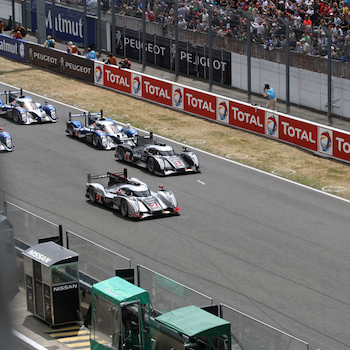In the run-up to Le Mans, we at wec-magazin.com are taking a look back at the great tradition and character of the great 24-hour race. In this article, we turn to the 2011 24 Hours of Le Mans – one race that may still be fresh in most fans’ memories, but which delivered an unrivalled battle of strategy and intrigue.
As Jim Roller in the Radio Le Mans booth said that night, there’s an awful sense of foreboding when a hush falls over a race track. In 2011, the track fell silent on two separate occasions. But the 2011 race will also be remembered for one of the most epic battles for overall victory in recent history.
The 2011 season heralded the start of a new era in endurance racing. For the first time in two decades, the 24 Hours of Le Mans was part of an official championship – the Intercontinental Le Mans Cup. The ILMC would prove to be the precursor to the current World Endurance Championship, which was announced by the FIA and the ACO in the run-up to the 2011 race.
In LMP1, Audi and Peugeot approached the 2011 season at the same part of their cars’ development curves – namely the very start. Peugeot had developed a brand-new 908 for the 2011 season, while Audi came to Le Mans will a new closed R18 TDI, albeit with a slight delay. Peugeot’s desire was to banish the demons of the 2010 race, in which all of its cars were forced to retire with suspension or engine issues, leaving Audi to take a relatively untroubled 1-2-3.
In a break with usual tradition, Audi appeared to have the upper hand on pace over Peugeot and qualified in first and second. But with margins of under half a second between the first five cars, it was clear that fans would be in for a close race. At 3pm on a slightly overcast summer’s day, the cars rolled through the Ford Chicane for the final time on the formation lap and the tricolore fell.
The Audis began the race up front, and the #2 car of Tréluyer/Fässler/Lotterer successfully converted its pole position by leading into the Dunlop Chicane. Behind the leading Audi, it was every man for himself as Allan McNish in the #3 Audi snapped at the heels of the three Peugeots. And so the 88th running of the 24 Hours of Le Mans began at a frantic pace, with the leading LMP1 cars squabbling among themselves in the first stints. Almost as soon as the first pit stops were being completed, the race was turned on its head.
Coming through the Dunlop Chicane on the way down to the Forest Esses, McNish in the #3 car tried to overtake a hesitant Timo Bernhard in the leading #1 car, before making contact with a GTE Ferrari and skidding off at alarming pace into the barriers. The Audi R18 smashed against the tyre wall, vaulting and spinning like an Olympic gymnast. The silence among the crowd was almost deafening, before fans broke into rapturous applause as a shaken but uninjured McNish emerged from his wrecked Audi. The race was barely an hour old and Audi were already one car down.
As the race progressed, the #2 car driven by Tréluyer/Fässler/Lotterer continued to lead and appeared to have the pace on its sister #1 car, of Rockenfeller/Berhard/Dumas. The reigning champions had been struggling with crash damage sustained in qualifying and all did not seem right with their R18. The greater pace of the Audi did come at a cost, however, as Peugeot enjoyed a significant fuel advantage over the German manufacturer. This advantage was largely negated due to the number of safety car periods. Right from the word go, it was a classic battle of strategy, pace versus efficiency.
The frantic combat at the front of the field was interrupted once again in the darkness and another hush fell over this great racetrack. Initially it was unclear what had happened, but the safety car was called and the usual process began. At Mulsanne Corner, the fire trucks and safety vehicles sprang into action and headed off in the direction of Arnage. Suddenly, on the TV feed, images appeared from a shaky CCTV camera of a huge debris field on the fast run down to Arnage, akin to that of a plane crash. Again, fans and commentators were unsure who was actually involved, but speculation soon spread that it was another Audi.
Minutes past before confirmation came that it was the #1 car driven, at the time, by Mike Rockenfeller. An onboard shot from the Audi then showed shocked viewers and fans exactly what happened: Attempting to pass a slower Ferrari GTE car at the run down from Mulsanne Corner to Indianapolis, Rockenfeller had planted his right rear tyre onto the grass and sent his Audi careering into the barriers. Thankfully, Rockenfeller emerged on his own and, as it would later turn out, escaped without serious injury. And so, against the trio of Peugeots, Audi had just one bullet left in the gun.
As dawn broke, all three Peugeots found themselves sharing almost the same piece of tarmac, with the #2 Audi not far behind. Passing and repassing each other around the 14km circuit, the racing was more akin to a 20-minute sprint race than any endurance event. On pit stops, the #7 Peugeot 908 (Wurz/Davidson/Gené) appeared to hold the advantage over its teammates in the #9 car (Bourdais/Pagenaut/Lamy) and the remaining Audi, but early on Sunday morning Alex Wurz ran wide at Indianapolis and into the barriers, losing three laps returning to the pits.
With just two cars remaining with a genuine shot at victory, it was a straight-up dogfight going into the last few hours. The Audi was at the limit trying to maintain its advantage, with Tréluyer and then Lotterer taking major risks dodging GT cars in traffic. It all came down to the final pit stops with under an hour left. Lotterer pitted his R18 for tyres and fuel, while the #9 Peugeot just took diesel, closing the gap to an agonisingly close 9 seconds. On fresher rubber than the French machine, the Audi had enough in the tank to take the chequered flag – but by just 13 seconds.
It was the closest competitive finish to a Le Mans 24 Hours since the famous 1969 race and the dawning of a new era for top-class endurance racing. No longer is Le Mans about perseverance, about lasting the distance; one tiny mistake can cost a team the race. Now it’s almost flat-out for 24 hours and to win you must balance risk with reward and a little bit of good fortune.
Image source: WEC-Magazin (Walter Schruff)

